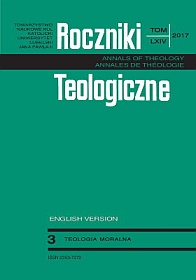Human Conception and the Status of Single–Celled Human Zygote from the Perspective of Catholic Bioethics
Abstract
In the discussions on the status of human zygote, the issue of its animation appears only occasionally. Current teaching of the Magisterium of the Church on the beginning of human life emphasises the fact that life of a new human being begins with the conception. The moment when single 2n diploid cell called zygote comes into being is very often considered as a start of a new human life. According to embryology, this takes place 12 to 24 hours after fertilization. The discoveries in epigenetics allow to claim the human character of a zygote is then defined. From the moment of conception, that is when the head of spermatozoon combines with oocyte cytoplasm and two pronuclei come into existence (the nuclei of both male and female gametes), the processes related to a new human life begin.
References
Arnold, Arthur P., Lusis, Aldons J. “Understanding the Sexome: Measuring and Reporting Sex Differences in Gene Systems.” Endocrinology 153 (2012): 2551–2555.
Bartel, Hieronim. Embriologia. Warszawa: Wydawnictwo Lekarskie PZWL, 2007.
Daniels, Robert, Bolton, Virginia, Monk, Marilyn. “Imprinted Expression of SNRPN in Human Preimplantation Embryos.” The American Journal of Human Genetics 63 (1998): 1009–1014.
Gibbs, W. Wayt. “Genom ukryty poza DNA.” Świat Nauki 1 (2004): 58–65.
Härle, Wilfried. “Menschenwürde—konkret und grundsätzlich.” Menschsein in Beziehungen. Studien zur Rechtfertigungslehre und Anthropologie. Tübingen, 2005.
Kohda, Takashi, Ishino, Fumitoshi. “Embryo Manipulation Via Assisted Reproductive Technology and Epigenetic Asymmetry in Mammalian Early Development.” Philosophical Transactions of the Royal Society B: Biological Sciences 368.1609 (2012). Http://rstb.royalsocietypublishing.org/content/368/1609/20120353 (access 13.05.2017).
Łukasik, Marcin, Karmalska, Jolanta, Szutowski, Mirosław M., Łukaszkiewicz, Jacek. “Wpływ metylacji DNA na funkcjonowanie genomu.” Biuletyn Wydziału Farmaceutycznego Warszawskiego Uniwersytetu Medycznego 2 (2009): 13–18. Http://biuletynfarmacji.wum.edu.pl/0902Lukasik/Lukasik.html (access 15.05.2017).
Machinek, Marian. Spór o status ludzkiego embrionu. Olsztyn: Wydawnictwo UWM, 2007.
Midro, Alina T. “Genetyczne i epigenetyczne uwarunkowania płci człowieka.” Gender. Spojrzenie z różnych perspektyw. Ed. Włodzimierz Wieczorek. Warszawa: Wydawnictwo Szkoły Wyższej Przymierza Rodzin, 2015.
Midro, Alina T., Hoser, Henryk F. “Problemy bioetyczne ingerencji medycznych zaburzających genetyczne i epigenetyczne uwarunkowania rozwoju człowieka.” Family Forum 5 (2015): 29–42.
Mieth, Dietmar. “Konfessionelle Identität in der biomedizinischen Debatte? Relecture der Beseelungstheorie bei Thomas von Aquin.” Ökumenische Rundschau 51 (2002): 315–327.
Otowicz, Ryszard. Etyka życia. Bioetyczny i teologiczny kontekst problematyki życia poczętego. Kraków: WAM, 1998.
Schockenhoff, Eberhard. Etyka życia. Postawy i nowe wyzwania. Opole: Wydział Teologiczny Uniwersytetu Opolskiego, 2014.
Sikora, Weronika. “Dziedziczenie epigenetyczne.” Zakład Biofizyki Obliczeniowej i Bioinformatyki. Wydział Biochemii, Biofizyki i Biotechnologii. Uniwersytet Jagielloński. Http://bioinfo.mol.uj.edu.pl/articles/Sikora05 (access 28.10.2014).
Speroff, Leon, Fritz. Marc A. Kliniczna endokrynologia ginekologiczna i niepłodność. Warszawa: MediPage, 2007.
Spork, Peter. Drugi kod. Epigenetyka, czyli jak możemy sterować własnymi genotypami. Warszawa: Wydawnictwo W.A.B., 2011.
Szewczyk, Kazimierz. Bioetyka. T. 1: Medycyna na granicach życia. Warszawa: Wydawnictwo Naukowe PWN, 2009.
Ślipko, Tadeusz. Granice życia. Dylematy współczesnej bioetyki. Kraków: Wydawnictwo WAM, 1994.
Watson, James D., Crick, Francis. “Molecular Structure of Nucleic Acids: A Structure for Deoxyribose Nucleic Acid.” Nature 171 (1953): 737–738.
Wróbel, Józef. “Kiedy ciało może przyjąć duszę.” W drodze 3 (199) (1990): 19–29.
Wróbel, Józef. “Godność poczętego życia ludzkiego.” Homo Dei 2–3 (1992): 36–51.
Copyright (c) 2017 Roczniki Teologiczne

This work is licensed under a Creative Commons Attribution-NonCommercial-NoDerivatives 4.0 International License.





